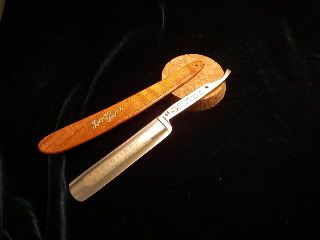Results 11 to 17 of 17
-
01-01-2009, 03:03 PM #11"My words are of iron..."


- Join Date
- Oct 2006
- Posts
- 1,898
Thanked: 995
I am guilty of being practical in this matter. I have access to LN at work. Have I tried this on blades of my own? Of course. There just wasn't enough benefit shown to be worth the money spent for the type of steels I use.
I'm heat treating the low alloy steels I use, optimally, and those blades are not likely to have any retained austenite to convert with LN. So it's money wasted on a process that adds nothing to the tool. It might even risk adding greater stresses.
For anyone really interested in making their own blades and doing their own heat treatment, stick to the simple methods. Really, before the 1940's or so, millions of very serviceable blades of all types have been manufactured without benefit of LN. In the end, it comes down to practicality.Last edited by Mike Blue; 01-01-2009 at 04:09 PM.
“Nothing discloses real character like the use of power. Most people can bear adversity. But if you wish to know what a man really is, give him power.” R.G.Ingersoll
-
01-01-2009, 03:28 PM #12

I had a pre-WWII Inox blade treated by Texas Knifemaker's Supply on a recommendation from John Crowley. It was less then $10.00 if I remember right. It did improve the blades ability to take an edge. Texas Knifemaker's Supply will only cryo treat stainless. For me it paid off.

-
01-01-2009, 05:44 PM #13

I asked a teacher about this.
Cryo treatment usually is done between the quench and the tempering, to release some stress from the quench, so cryo quench a blade that is already tempered won't change much.
(that or my teacher was an idiot... wich is also possible)
Also if you drop a blade that just got out from nitrogen, it will probably break.
EDIT: I read it again, I'm not sure what you mean: For razors you make, why not. For vintage, forget :SLast edited by cybrok; 01-01-2009 at 09:30 PM.
-
01-01-2009, 08:56 PM #14Senior Member

- Join Date
- Apr 2008
- Location
- Wales UK
- Posts
- 1,087
Thanked: 84
My pickups and other bits of my Fender Strat are cryo treated by www.callahamguitars.com
They sound good
M
-
01-01-2009, 11:07 PM #15illegitimum non carborundum



- Join Date
- Jan 2008
- Location
- Rochester, MN
- Posts
- 11,552
- Blog Entries
- 1
Thanked: 3795
-
01-02-2009, 02:56 AM #16"My words are of iron..."


- Join Date
- Oct 2006
- Posts
- 1,898
Thanked: 995
-
01-04-2009, 08:10 PM #17Senior Member

- Join Date
- Oct 2008
- Location
- Tolland, CT
- Posts
- 263
Thanked: 85
My understanding is that cryo treatment (usually in LN) is used to remove retained Austinite. Unless you are using stainless or highly alloyed carbon steels, you are unlikely to have retained Ausitinite in the first place. That said, Tim Zowada is cryo treating his O1/L6 Damascus razors, so you might check with him to see what benefit he is obtaining from the process. (His website mentions "dimensional stability", but I'm not sure exactly what he means.)
Remember, if you do decide to cryo your blades, you need to temper them again when you are done. Otherwise, you will have untempered Marteniste in your blades, which can lead to failure.


 LinkBack URL
LinkBack URL About LinkBacks
About LinkBacks







 Reply With Quote
Reply With Quote One of these days your students will talk you into trouble...
One of these days your students will talk you into trouble...
